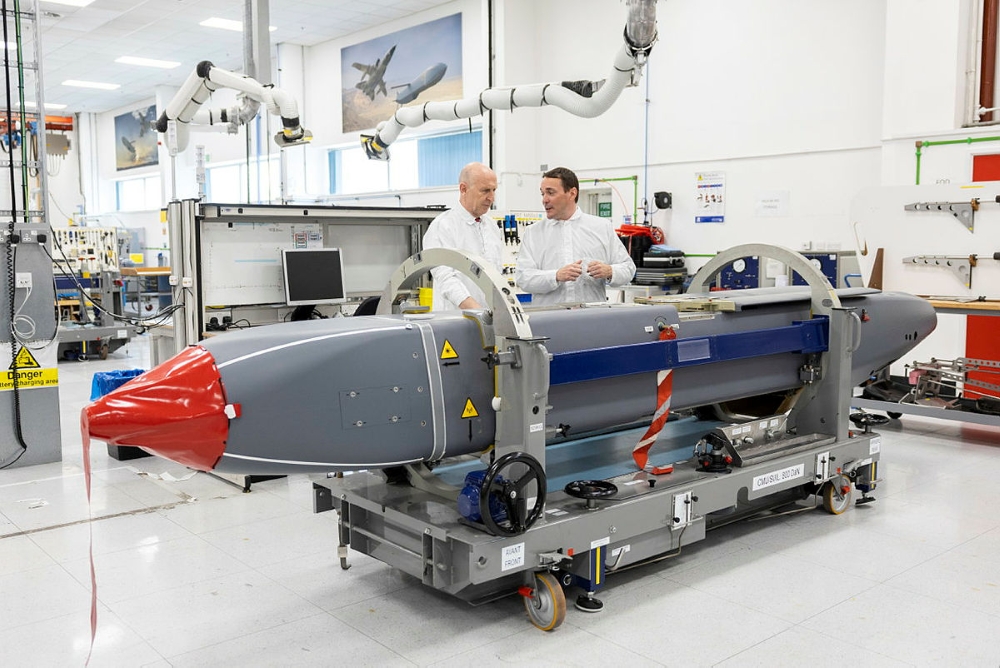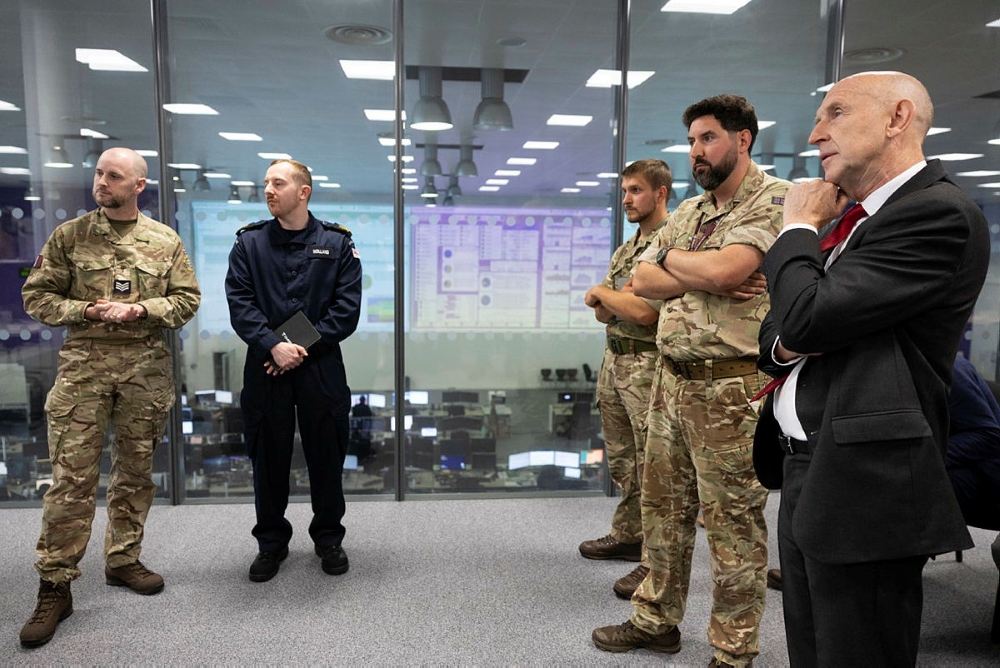
Before the Secretary of State for Defence finally stood up in the House of Commons, in the afternoon of Monday 2 June, to officially unveil the Strategic Defence Review, the government parcelled out a number of early announcements over the weekend and in the morning. Prime Minister Keir Starmer chose to publicly announce the conclusions of the Review using the hull blocks of the future Type 26 frigates HMS BELFAST and HMS BIRMINGHAM as his background, delivering a speech within the newly completed Janet Harvey Hall within the BAE Systems shipyard in Govan.
The Speaker of the House and the Opposition made their displeasure felt and for a long time Parliament lamented the breach of the Ministerial Code that requires announces of such significance to be made in the House and with the documents made available in good time. After that, while still waiting for the Secretary for Defence’s statement, the House vainly attempted to get some clarity on reports by The Times that the SDR would contain plans for a tactical, air launched nuclear capability to be acquired. The Opposition questioned the Parliamentary Under-Secretary of State for the Armed Forces, Luke Pollard, while waiting for John Healey to finally arrive.
It was a valiant but ill-fated attempt and, amazingly, even the eventual release of the document, the statement of Secretary John Healey and the subsequent questions and answers have been unable to provide a definitive, clear answer on what is potentially one of the most significant decisions to be taken in many decades.
In truth, at the end of a stormy day of angry exchanges in the House of Commons, the reality is that we now know even less than we did before reading the document, since everything about it is extraordinarily vague.
The only “detailed” measures in the Review ended up being those which were announced early, over the weekend.
It is for the most part not the fault of the "Reviewers", led by Lord Robertson, a former Defence Secretary, who conducted the Labour party’s last major Defence Review in 1998 and also served as Secretary General of NATO (1999 to 2003). The trio leading the Review was completed by Dr Fiona Hill, who was Deputy Assistant to the US President and Senior Director for European and Russian affairs on the U.S. National Security Council from 2017 to 2019; and by General Sir Richard Barrons, a former Commander Joint Forces Command and former Deputy Chief of the Defence Staff.
Their task was difficult, and the government handed them a shifting goalpost. They were asked to make recommendations without a clear fiscal envelope, initially with the instruction that the budget would not go beyond 2.3% for the duration of the Parliament.
The government now categorically insist 2.5% was always a firm commitment, but it was really not until the “Trump scare” early this year. The Reviewers themselves quietly but quite explicitly confirm it in the introduction to the Review, where they write “we were asked to conduct our Review within the budgetary context of a transition to 2.5% of GDP. We acknowledge with relief that this will apply from 2027 and not later."
That funding decision prevented the Review from being full of cuts – other than the long list of ships and helicopters removed from service early already in November 2024 – but it’s not surprising that genuinely new commitments are almost nonexistent and detail is minimum.
At the same time, even the little that the Review does say is ambitious if it is to be fully realized and will depend on the Defence budget continuing to rise towards 3% of GDP into the next Parliament.
Over the weekend the government managed to contradict itself rather spectacularly, first claiming that 3% by 2034 was a firm promise and then backtracking towards a more prudent “ambition” to be hit when conditions allow. With NATO expected to soon set new targets for Defence expenditure even above 3%, it is indeed very likely that the next Parliament will continue to increase the military’s budget, but the uncertainty and contradictions certainly didn’t make the SDR’s launch particularly convincing.
Return of a tactical, air-launched nuclear capability?
We went into this day knowing what the plan for the Nuclear Deterrent was; now we are no longer sure. The Times, briefed in advanced by someone from the MoD, had reported that the UK would acquire F-35A jets in order to field a tactical nuclear capability, presumably by having American B61-12 weapons deployed to RAF Lakenheath, a base which in the past already was part of the NATO Nuclear Sharing system before it was downsized.
For months now there have been reports, never officially confirmed, about B61 bombs returning to Lakenheath, where some 22 of the 33 vaults for nuclear bombs are believed to have been recently refurbished.
The Review as published is far less categorical than the Times’ report: the word “tactical” is never used in the paper in the context of nuclear weapons nor is there any specific recommendation about adopting new air-launched weapons of any kind. The Review language only says, and we quote this key passage word for word: “the UK will need a full spectrum of options to manage escalation as part of NATO, delivered by its nuclear and conventional forces in combination. Defence should commence discussions with the United States and NATO on the potential benefits and feasibility of enhanced UK participation in NATO’s nuclear mission”.
That “enhanced UK participation” could take multiple forms: it could be anything from UK jets working as escorts for NATO F-35As carrying B61s to the UK developing a sovereign air-launched nuclear weapon, for all we know.
Pressed on the matter, and asked specifically about plans to potentially procure F-35As, the Secretary of State for Defence has refused to give clear answers but said that the Review’s “recommendation” was accepted in full and “discussions” are underway.
This leaves an enormous amount of uncertainty hanging, with clear answers potentially not coming for months. The shape of the entire UK F-35 program is once more in question as the Review does not dare giving quantities. The only thing that the document says is, and again we quote word for word, “More F-35s will be required over the next decade. This could comprise a mix of F-35A and B models according to military requirements to provide greater value for money”.
Prior to the release of the SDR, the UK had plans, in the process of being firmed up, to acquire a second tranche of 27 F-35Bs, potentially starting with production Lot 18. Now it’s impossible to say with confidence that this remains the plan. How many F-35s will be procured, when and what type they will be is a question currently without answer. Will F-35A happen, and if it does, will it come on top or instead of the second Tranche of Bs, which was to enable the formation of a third frontline, carrier-capable Squadron by 2033?
This, and many other details, might not be known before the MoD completes and releases the new Defence Investment Plan, a new document that will detail equipment and infrastructure plans replacing the previous Defence Equipment Plan which used to be released once a year until 2023. According to the Secretary of State, this new paper “will be completed and published in the autumn”.
The lack of clarity extends to a figure that has been repeated again and again during the day but that will need exploring in detail: according to the Government, 15 billion pounds will be invested in this Parliament on the “sovereign warhead programme”.
This is an enormous amount of money, particularly if spent over the course of a single Parliament (5 years) and it is far from clear what exactly is being included within the name “sovereign warhead”. The UK is going to develop a new national nuclear warhead for TRIDENT, the A21Mk7 ASTRAEA. The “Mk7” in the name indicates the aeroshell that contains the warhead for re-entry in atmosphere and that includes the non-nuclear firing system. The Mk7 aeroshell development is led by the United States, with the system being common to the new American W93 warhead.
If 15 billion are required for the sole ASTRAEA then earlier estimates of how much it would cost to develop a new national warhead were wrong by a factor of 3, since the highest figures given were in the region of 4.8 billion pounds. In a November 2023 report, the US estimated the whole cost of its own W93 project at a sum roughly equivalent to 15 billion pouds but spread on many more years (out to 2047).
While the US facilities for the production of nuclear warheads are always active on multiple projects at once so probably have a far higher degree of readiness in both infrastructure and know-how, it seems mind boggling that the “warhead” component alone for the UK could possibly spend as much as the entire W93 program, and over just 5 years instead of over 20. The disproportion boggles the mind.
The entire Defence Nuclear Enterprise expenditure in FY 2024/25 was 10.9 billion across all programs, from warhead to nuclear reactors to the building of submarines and the dismantling of old, decommissioned boats, to further put those 15 billion into perspective.
The assumption is that the figure actually relates to a lot more than just the new warhead, but clarity will be difficult to obtain.
A big boost for SSN-AUKUS
It is something the previous government was already working upon, but that remained uncertain right until it was announced, late on Sunday, by the MoD: the Royal Navy has a new long-term target of fielding 12 SSN, up from 7.
The Review paper itself, while recommending an increased number of submarines, stopped short of providing a number but Government agreed on 12. Firming at least this target up early is essential to enable BAE Systems and Rolls Royce to proceed with the massive infrastructural investments for their facilities respectively at Barrow in Furness and Derby.
Rolls Royce will be providing the nuclear reactors for not just the British boats but for the ones for the Royal Australian Navy as well, so ever since 2023 has been working on plans to “double” the size of its production site at Raynesway (Derby). Back in January, Rolls Royce picked AtkinsRéalis and Mott MacDonald as the specialists that will design the new structures.
BAE Systems, on its part, has been working on the construction of a new Research and Development facility (Project SPARTAN) in Barrow and on another, even more important investment for a new “production line” for submarine blocks to support the construction of more boats, in a shorter timeframe.
In 2023 BAE Systems had presented to the authorities a first project which envisaged the construction of a new block assembly line to be known as Ramsden Dock Facility which was going to have a central manufacturing hall approximately 66 m wide by 175 m long, with a height of approximately 45 m. The huge structure was going to have 8 pre-outfit bays on each side (16 in total) of the great central aisle and would have seen the employment of 400 workers by day, up to 250 by night, with 165 office workers in adjacent structures.
The application to build the Ramsden facility was however subsequently withdrawn, with BAE instead purchasing the nearby disused gas and fuel storage field, subsequently presenting plans to level the whole site and create a solid, elevated platform. It is expected that a new and even larger production facility for submarine blocks will be built here, with BAE likely to file the plans to the authorities in the near future.
While final assembly of the submarines will continue to happen within the enormous Devonshire Dock Hall, which has more than enough space for work to proceed on 2 or more submarines at the same time, the new facility is needed to ensure hull units can be produced at a much faster pace. In the words of Healey, the new investment will lead to a “double production line” in Barrow.
The official objective is to establish an 18-months drumbeat in the delivery of new submarines. Construction of the first SSN-AUKUS is expected to begin in 2028 for delivery in the “late 2030s”, with the project currently in detailed design and long lead procurement phase.
Orders of material for the second boat will have to follow soon if the accelerated procurement is to have any chance of becoming reality.
The Royal Navy will only see the number of SSNs growing if SSN-A is produced faster and the existing ASTUTE-class SSNs can live on enough so that the new submarines add to them, rather than replace them. Even so, it’s obviously a process that will require many years.
As part of the submarine enterprise, plans are being develop to open a new sovereign production line for the nuclear fuel destined to power the reactors.
An early indicator of the seriousness of plans for a larger SSN fleet will also be Project EUSTON, a plan for the procurement of “at least” 2 nuclear-certified floating docks for installation in Faslane: the new docks are much needed to ensure there are options for the docking of submarines needing maintenance. At present the options are strictly limited to the shiplift in Faslane, for limited works, and Dock No 15 in Devonport for major refits.
As we know, Dock No 10 is also being rebuilt in Devonport to provide a suitable facility that will be able to support both the new DREADNOUGHT-class SSBNs and the SSN-A when they arrive.
The plans for ammunition and for a more resilient production capability
6 billion pounds are to be spent within this Parliament on “munitions”, with 1,5 billion supporting the establishment of an “always on” production pipeline. This much needed measure is meant to ensure that, in times of crisis, it does not take years to reactivate a dormant production line as has happened when weapons such as NLAW suddenly became high in demand with the Russian invasion of Ukraine. “At least” 6 new factories of “munitions” and energetics will be opened, creating over a thousand new jobs. “Up to” 7,000 “long range weapons” are to be acquired, supporting 800 UK jobs.
The devil is, once again, in the detail, which is completely absent. It is highly likely that one of the 6 new factories will be a new rocket motors production line by Roxel. Plans for this were indirectly unveiled following a successful ground test of a newly manufactured rocket motor late last year.
It’s impossible at the moment to say what the other factories will be or when they will start producing. Investment on the production of explosives, pyrotechnics and other energetics should be announced over the coming months, with engagement with industry already underway and tenders announced for a new deal covering explosives and another covering naval and air countermeasures, which will undoubtedly involve Chemring.
Separately, MBDA UK has announced a first tranche of 200 million pounds of investments in further expansion of its production lines at Bolton. The Company committed to investments totalling 500 million as part of the renewal of the 10-year Complex Weapons partnership with the MoD.
BAE Systems continues to work to expand its production capacity for 155 mm shells in particular and in February announced a major technological breakthrough in the production of RDX explosive. The use of continuous flow processing to synthesise explosive material removes the need for Nitrocellulose and Nitroglycerine in propellant production. These components are in short supply globally and becoming more and more expensive.
After previously announcing an “8-fold” increase in production rates, BAE said it can make the increase “16-fold” in the space of 2 years thanks to the new methods for the production of RDX, especially since the process can be “containerized” allowing facilities to be set up very quickly.
Earlier this month, Rheinmetall also formalized its plan for opening a gun manufacturing hall in Telford which will received forged metal from Sheffield Forgemasters and finish it into 120 and 155 mm barrels expected to be used for CHALLENGER 3 and BOXER RCH 155.
The US colossus Anduril is also reportedly considering opening the second of its multi-product “ARSENAL” mega factories in the UK; while Helsing could soon produce HX-2 loitering munitions in a new UK facility.
These prospective plans may or may not be part of the “6 factories” announced by the government.
It is similarly impossible to say exactly what will be included in the “7,000 long range weapons”. In theory, the UK has long overdue intentions of ordering unknown amounts of MBDA BRIMSTONE missiles for ground launch for the British Army anti-tank needs. It also plans the development of a new Land Precision Strike missile, designed by MBDA, to provide the M270 GMLRS with a new munition for the destruction of moving armour at ranges of over 100 km. If these contracts will finally be signed, they might be part of that target.
In theory, the Future Cruise and Anti-Ship Weapon project should soon move into Demonstration and Manufacture phase. A joint announcement could come at the next UK-France summit, planned for July.
We feel obliged to mention GMLRS and Precision Strike Missile as well: these American weapons have a key role to play in British Army plans for the future and logic would suggest discussing with the Americans the possibility of opening a factory in the UK. It’s not clear if work is ongoing in this sense.
UK and Germany have also recently announced the intent of jointly developing a novel Deep Precision Strike Capability with a range exceeding 2,000 km within the wider European Long range Strike Approach (ELSA). Subsequent Written Answers have however, rather shockingly, revealed that it hasn’t even been decided yet whether it will be a cruise, ballistic or hypersonic missile and what platform(s) will be launching it, so it’s hard to say what, if any, role this capability plays in the plan.
A number of other initiatives are in the pipeline for one-way strike effectors and loitering munitions (BRAKESTOP and Medium Range Precision Strike, most notably) but it’s again to early to talk of numbers or even to say if they count against the 7,000 or not.
A “hybrid” Royal Navy
The Navy gets the backing it sought for its ambitious projects in terms of uncrewed capabilities. The Review recommends to create an evolved “hybrid” navy mixing crewed and autonomous vessels. In particular, Project CABOT for an ASW barrier in the North Atlantic gets full backing. CABOT is the successor (and a step up in ambition) from experimental and conceptual activities carried on so far under the national Project CHARYBDIS (itself part of the ASW Spearhead portfolio of sonar enhancements and sensors development) and through the NATO ASW Barrier smart defence initiative, which has the UK as lead nation.
Under CABOT, the Royal Navy hopes to develop a first deployed, low-manned / remotely operated “ASW as a service” system which would be delivered under a Contractor Owned, Contractor Operated, Naval Oversight (COCONO) model. This first phase is known as ATLANTIC NET and would see contract-owned low-manned or uncrewed assets gather acoustic data, triage it with AI/ML algorithms, and supply it to a secure Remote Operations Centre (ROC) for analysis by Royal Navy staff. This would deliver increased mass and persistence at sea quickly and “releasing RN platforms for other tasking”.
Subsequently, BASTION ATLANTIC would see a transition to Royal Navy-owned and operated Uncrewed Surface Vehicles, which the tender identifies as “Type 92 sloops”, and Uncrewed Underwater Vehicles identified as Type 93 Chariots (a nod to the world war two British “human torpedo” with the same name), alongside a host of other sesnors. ATLANTIC BASTION would also “consider the use of UK developed Underwater Battlespace Area Denial (UBAD) capabilities” which strongly suggests a reborn interest in the UK for maritime mines.
A pipeline notice was published by the MoD days before the Review, announcing the intent of placing a first 24 million pounds contract for the ATLANTIC NET phase in the coming months. The formal tender release is expected at the end of July with contract start in September.
The Review looks ahead to ATLANTIC BASTION already, with the Type 26 frigates supported by uncrewed surface and underwater vehicles. Suitable ASW platforms that can fit within the Type 26 mission bays are a further recommendation in the document.
The Royal Navy currently has 2 experimental vessels which will hopefully lead more or less directly to the “Type 92” and “Type 93” respectively: the first is the XV PATRICK BLACKETT ship, which in the future should demonstrate Level 4 autonomy at sea (4 is “full” autonomy, whereas 3 is remote control). The Royal Navy has already released RFIs for ASW / MCM sensor packages for a USV “around 40 meters long”.
PATRICK BLACKETT is a Damen-built Crew Transfer Vessel and the Netherlands have already announced the intent to purchase 2 similar, slightly larger vessels for use as “low-manned” adjuncts supporting warships with a containerized load of loitering munitions and BARAK surface to air missiles. This provides more than a clue to the potential shape of the “Type 92 Sloop”. PATRICK BLACKETT has repeatedly taken part in NATO REPMUS events in Portugal centered on the ASW barrier project, as has Thales’s HALCYON USV, the prototype for the USVs used by the UK-France MMCM mine countermeasures solution. For the occasion, HALCYON was instead fitted with a thin towed array for ASW.
The underwater demonstrator is the 17-ton extra large UUV (XLUUV) built by MSubs under project CETUS and recently commissioned as XV EXCALIBUR. This uncrewed submarine will hopefully lead to the “Type 93” operational capability.
Other ambitious USV projects have been named in the last few weeks: Project LILY has been launched to procure a single, contractor supported, COTS (Commercial Off-The-Shelf) Uncrewed Surface Vessel (USV) and a Remote Operations Centre (ROC) for year-round, global, open ocean operations. The USV will be configured for hydrographic survey work and military data gathering and will include a 2-year period of Government Owned Commercially Operated Support before transitioning to a Government Owned Government Operated solution with commercial support. The formal tender is expected in September with contract start in January 2026.
The Royal Navy has also revealed its early thinking for a Type 91 "arsenal" USV with vertical launch missile cells that would bring additional firepower to complement the future crewed Type 83 destroyer, the intended Type 45 replacement in the second half of the 2030s.
De facto, the Royal Navy is already a “hybrid” service thanks to the uncrewed underwater gliders and data-gathering floats used by Project HECLA to survey the Atlantic and thanks to the uncrewed “systems of systems” for mine countermeasure of the Mine Hunting Capability (MHC) project. MHC gets a vote of confidence and progress with Block 2 plans is recommended, but what is new is the political backing for more and new embarked uncrewed air platforms.
The Government has committed to developing the first “hybrid carrier air wings” in Europe by bringing drones aboard the QUEEN ELIZABETH class. While some experiments have already been carried out and HMS PRINCE OF WALES’s air wing includes Malloy T-150 load carrying quadcopters for small ship to ship and ship to shore deliveries, the Navy has far more ambitious plans to field Autonomous Collaborative Platforms (ACPs) alongside the F-35B.
The Review backs those ideas entirely and recommends that ACPs to be developed for the Royal Air Force must be carrier-capable. The Review also suggests that “long range missiles/effectors” launched directly from the carrier’s deck could be part of the hybrid air wing.
The Review also repeatedly endorsed the upgrade of the RAF’s MQ-9B with “maritime surveillance” capability to complement P-8 POSEIDON and other uncrewed assets in the context of CABOT/ATLANTIC BASTION and beyond. This is one of very few specific pieces of kits mentioned by name and with clear instructions.
“Maritime capability” is likely to involve the addition of a centreline maritime radar, probably the Leonardo SEASPRAY 7500, and pods with G-size sonobuoys by Ultra. The development of these small factor buoys has been specifically supported by the Royal Navy and Ultra and General Atomics have recently confirmed their teaming up to operationalize them.
The review does not mention specifically the Short Take Off and Landing kit that General Atomics is testing in the wind tunnel and that, if successfully matured, would enable MQ-9B PROTECTOR to embark on the QE-class carriers. As of 2024, the RAF confirmed there was interest in the capability with a notional 2028 in-service date if backing came through the Review.
The Royal Navy would be particularly interested also in another General Atomics proposal, involving podded radars for Airborne Early Warning. If the MQ-9B STOL will become a reality, complete with AEW and ASW payload options, the Royal Navy will have found a fantastic force multiplier. A new AEW solution is wanted by 2030 so MERLIN can offload its current AEW commitment with the CROWSNEST kit and return to focus “only” on ASW.
While never mentioned directly, the rotary wing drone PROTEUS by Leonardo UK, expected to soon have its first flight, should also benefit. The Royal Navy hopes PROTEUS will complement MERLIN and reduce the pressure on it.
Type 45 destroyers and their planned successor, the Type 83/Type 91 pair armed with Future Air Dominance System, a new radar and missiles combination to succeed to SEA VIPER, get an endorsement for their key importance in air and missile defence.
As announced previously, Type 45s should be the first ships to get fitted with an operational laser weapon developed from the DRAGONFIRE demonstrator. “Nearly 1 billion” of funding will go towards Directed Energy Weapons projects. Earlier in the year, the government announced plans to have 4 ships fitted with lasers by 2027.
The Littoral Response Groups of the Royal Marines also get an explicit backing, especially in the NATO High North context. This bodes well for the project for up to 6 new Multi Role Strike Ships destined to replace the BAY class LSDs and RFA ARGUS in the early 2030s. The project is supposed to progress through its business case sometime this year.
The Review doesn’t add any detail, however, leaving it all for later.
According to The Times, the expectation is that the Navy will get backing for growing to 25 escort ships. With 6 Type 45 in service, 8 Type 26 and 5 Type 31 in order, this would require 6 more frigates. In theory the project for building them already exists: the Type 32 remains in Concept Phase.
The Review does not provide numbers and never mentions Type 32, so again we’ll have to wait for actual project progress later this year.
The Royal Air Force
We already spoke about the embarrassingly confused F-35 situation. More of them are needed, but there is no indication of numbers, dates or even type so all that’s left to do is wait for actual decisions to be made and announced. Absolutely no new detail is added about plans for upgrading TYPHOON either.
MQ-9B PROTECTOR is directed towards the sea in no uncertain terms, as we already explained, and another platform gets a specific recommendation: the E-7 WEDGETAIL Airborne Early Warning and Control aircraft. The Review recommends buying more, seeking economies of scale through cooperation with Allies: since the RAF ordered 5 and cut down to 3, USAF and NATO AEW Force both announced plans to procure E-7.
It is clear that the Reviewers would want to buy to be expanded at least back to the original 5, but they stop short of saying so explicitly, instead writing: “further E-7 should be procured when funding allows”. Will their recommendation turn into reality? The official line is that “all” Review recommendations have been accepted, but in practice we will have to, once more, wait and see.
The Global Combat Aircraft Programme is confirmed as priority but with no new detail at all. Autonomous Collaborative Platforms are recommended, and they must be carrier capable.
Existing plans to procure some 6 additional A-400 ATLAS get an (unspecific) endorsement as well as it is recommended “augmenting the existing fleet of A-400M with either more A-400M, civilian charter, and/or sponsored service options, reducing routine demand on RAF air transport that does not require military capability”.
Chartering is recommended also to remove pressure from the VOYAGER tanker fleet, including even in the air refuelling role away from the frontline. This is a curious recommendation to make because the VOYAGER fleet is operated under a strict contract with the Air Tanker consortium which has an exclusivity clause that would force the MOD to pay compensation for chartering capability rather than making full use of the VOYAGER fleet first. It’s not clear how this conundrum would be solved. There is no way to tell if plans for procuring the tanker kit for A-400 is on the cards: as well as complementing VOYAGER, the A400 would finally introduce helicopter air to air refuelling capability that MERLIN HC4 and some of the CHINOOKs could then exploit.
Acquiring this capability has been on the wish list for many years and it’s not clear if the MoD will now give it any sort of new consideration.
The RAF gets one wish granted in that the Review recommends the procurement of “a cost effective fast jet trainer” to replace both HAWK T1 (in use with the RED ARROWS) and HAWK T2.
The Chief of the Air Staff had gone public well before the release of the Review saying he wanted to see HAWK T2 (out of service date 2040) replaced early. The big question now is: how? The government has painted itself in a corner promising to back British jobs and firms first of all and faces demands to ensure the RED ARROWS continue to fly on British-made jets.
Startup AERALIS continues to push its concept of a modular fast jet trainer, hoping to get funding and backing, but this British option faces very stiff competition in the form of the likes of T-7 RED HAWK, M-346 MASTER and even the Turkish HURJET, which Turkey has been showing off to the Secretary of Defence in a not too discreet attempt to get to a quid pro quo exchange: Ankara buys TYPHOON, London buys HURJET. Obviously, the Review does not provide any kind of indication.
The British Army
Plans for the British Army are the vaguest of all. It is confirmed that the main role for the Army will be to deliver one of 2 Strategic Reserve Corps at the direct orders of SACEUR within the new NATO structure. France is to supply the other SRC.
The Allied Rapid Reaction Corps HQ will have both of the Army’s Divisions but the Review literally didn’t even dare repeat the commitment to having 6 brigades across the 2. Only one Division structure (presumably 3rd Div) is (very vaguely) detailed as having “a fully deployable Headquarters, three manoeuvre brigades with armoured and mechanised capabilities, support brigade, and associated enablers.”
The thorny issue, which was always how to rebuild 1st Division into a credible, full 3 brigades structure of its own, is completely untouched by the text.
The Review however states that “Global crisis response at very high readiness in the land domain should be led by 16 Air Assault Brigade”, as is already the case. This appears to recommend taking it out of 1st Division again to keep it as the “stand-alone” rapid responder seventh brigade, but again we can only guess.
The Army should “become 10 times more lethal by 2035” through Recce-Strike tactics and a new balance of armour, long range missiles and uncrewed effectors. The ongoing project ASGARD is thus endorsed: through a combination of new communication systems, weapons and one-way strike drones it is meant to dramatically enhance the ability to find (‘recce’) and destroy (‘strike’) enemy targets. “It brings together digital networks and data, Artificial Intelligence (AI), and intelligence capabilities with firepower to find and strike enemy forces at greater distances than ever before across the battlespace”.
The Army is to evolve towards a notional ‘20-40-40’ in which 20% are crewed platforms to control 40% ‘reusable’ platforms (such as drones that survive repeated missions), and 40% ‘consumables’ such as rockets, shells, missiles, and ‘one way effector’ drones. This is all the Review dares to say. Absolutely no detail on platforms or structures is provided, leaving it all for later. Unsurprisingly there is no big expansion in sight for headcount, either, but there is a nonetheless incredibly important commitment to increase regular manpower from 73 to “at least” 76,000 going into the next Parliament.
The voluntary active Reserve, currently with a target of 30,000, should also “expand by 20% when funding allows”. While very modest, the growth would be invaluable to enable the Army to rebuild missing enablers such as Artillery and Air Defence batteries, Logistics and Engineer units. A new Gurkha-manned artillery regiment is being formed, the King’s Gurkha Artillery, which is planned to man one Close Support gun battery in each of 1 Royal Horse Artillery, 19 Royal Artillery and 4 Royal Artillery regiments. Thanks to this announcement, this should be a first injection of additional manpower, fundamental even just so the Royal Artillery can absorb the increase in the number of M270A2 GMLRS launchers. The Army has at least 61 such launchers on order, with the first refurbished vehicles returning from the US this year. This is already a growth of almost 100% from the 35 M270 in use so far (temporarily reduced to 29 as 6 have been handed to Ukraine). 15 more launchers are thought to have recently been ordered, completing the full planned purchase of 76 (plus 9 M270 recovery vehicles) but we are still waiting an official confirmation.
The New Medium Helicopter
There is still no way to tell if the New Medium Helicopter is going to happen or not. Even when pressed specifically on the matter, the Secretary could only confirm that “the process is underway” and decisions will be made as soon as possible. Leonardo UK is the only bidder left, with its AW-149 that would be produced at Yeovil.

Air and Missile Defence
A very underwhelming commitment to invest “£1 billion in this Parliament to further strengthen in particular radar, communications and the integration of our missile and air defence” is all that was forthcoming.
It is not at all clear if Project LEWIS, a standing commitment to build a new anti-ballistic missile defence radar possibly on the island with the same name, is still in play. The UK has promised this system not just to itself but to NATO and obtained US clearance for acquiring a Long Range Discrimination Radar set already in 2022.
All that can be done is take stock of what has emerged so far outside of the Review process. The British Army has an ongoing Land Ground Based Air Defence multi-project, 10-year programme of enhancements and new capabilities revolving around Short-Range Air Defence (SHORAD), Medium-Range Air Defence (M-RAD), Counter Small Aerial Targets (C-SAT) for SHORAD and MRAD; and All-Arms Counter Small Uncrewed Aircraft Systems.
Days ago the MOD released a pipeline notice warning industry of the imminent launch of the phase of maturation for the new vehicle-mounted Short Range Air Defence solution for the British Army, destined to replace the current STORMER HVM tracked vehicles.
The notice signals that a contract should be concluded by the end of August, with a value of 48 million pounds (VAT included) for the definition of the Mounted-SHORAD Fire Unit (MSFU), through “Vehicle Selection and Multi Mission System (MMS) Assessment Phase (AP) activities”.
In practice, the MOD wants to define the base vehicle to be used and the new multi-mission turret which is expected to launch existing LMM and HVM STARSTREAK missiles but also integrate further capability, for example against drones, which lead to the expectation that a 30 mm gun will be included.
The notice does not, however, help us define in detail what we are looking at. The British Army is, or at least was until recently) planning to field both a “heavy” manoeuvre SHORAD / Counter Small Aerial Targets (C-SAT) capability based on BOXER and a lighter capability using vehicles from the Land Mobility Programme as base.
The fact that a “vehicle selection” is necessary suggests we are looking at the latter requirement, connected to the Land Mobility Programme. It’s not clear where that leaves the BOXER part of the capability.
The Land Mobility Programme is expected to select soon a Light Mobility Vehicle to replace Land Rover and PINZGAUER vehicles; a Light Protected segment solution including but potentially not limited to JACKAL and FOXHOUND, and a Medium Protected segment which will replace MASTIFF, RIDGEBACK, WOLFHOUND fleets as well as part of the remaining FV432-series of tracked vehicles.
The base vehicle for M-SHORAD is most likely coming via Medium Protected segment. A strong contender for the Multi-Mission System (the “turret”) is Moog, which is aggressively pursuing the requirement with its Reconfigurable Integrated-weapons Platform (RIwP) with 30x113 mm gun and 8-missile capability. The RIwP has already been showcased on some of the leading candidates for the Land Mobility Program, including the KNDS DINGO and the Supacat HMT.
New capability is also on the way for the Medium Range Air Defence segment, currently delivered by SKY SABRE batteries (MBDA CAMM missile). A separate notice warns that the tender will be released at the end of October for the “Capability Uplift Package 2”. It is not clear, however, what this will involve. The expectation is that at some point SKY SABRE will adopt the longer range CAMM ER missile and, potentially later on, the MR variant, with range in the 100 km region, that UK and Poland plan to cooperatively develop.
Again, the LGBAD comprises another, separate project for a new Command and Control layer for air defences, and a Written Answer by Minister for Defence Procurement Maria Eagle, filed on 23 April, suggests that elements of this program will deliver by July 2026. Her answer says that Medium Range AD capability by that point will include “2 Surface-to-Air Missile Operations Centres, and 2 enhanced Wireless Enabled Network sets”. No further detail was provided, but the description suggests the UK might be about to adopt the US Integrated Battle Command System (IBCS) by Northrop Grumman. This system, also adopted by Poland for both WISLA (PATRIOT) and NAREW (CAMM ER) batteries and which Germany also intends to adopt for its PATRIOT batteries, was picked for “assessment” by the UK MOD in 2024 with a 6-months study contract award to Northrop Grumman UK.
Again, LGBAD work streams also include new C-UAS capabilities. After delivering an “on-the-soldier” package of wearable sensors, electronic “guns” and Smartshooter SMASH X4 advanced computerized sights to enable counter-drone firing with standard assault rifles, the focus is now “switching to higher level UAS detect and non-kinetic systems, and upgrades to vehicle mounted weapon systems to enable them to engage UAS” in the words of Minister Eagle.

Space
In Space, the Review is supportive of ongoing efforts to build a multi-sensor ISR sovereign constellation and Precision Navigation and Timing alternatives.
It also recommends efforts to secure access to space, and the planned launch of the first rocket to space from the Saxa Vord spaceport later this year should be an important milestone towards the ability to put at least small satellites into orbit directly from the UK.
"The MOD should invest in the resilience of UK military space systems with a focus on space control, decision advantage, and capabilities that support the 'Understand' and 'Strike' functions. The department should periodically review the SKYNET 6A and SKYNET 6EC satellite communications programmes to ensure this capability will be resilient and operationally relevant upon entry into service."
The reviewers are not too kind to SKYNET, saying that "it must maintain operational relevance or be supplanted by alternatives." This is, on the face of it, perfectly rational, but SKYNET is by far the most complex and expensive space programme for the UK, and switching to other communication solutions such as, presumably, proliferated low Earth orbits is not an easy call to make.
SKYNET 6, a more than 5 billion pounds strategic programme, has one communication satellite already in final integration ahead of launch next year (SKYNET 6A) and plans to launch a single dedicated UHF satellite around 2028, followed by up to three high-availability, military-hardened GEO satellites incorporating X-band and Mil-Ka-band milsatcom payloads. A secure Telemetry, Tracking, and Command (TT&C) capability operating in the X-, Mil-Ka-, and S-bands is required, along with intersatellite communication links that enable payload traffic and TT&C transmissions. The satellites must have a minimum life expectancy of 15 years. The first of these three satellites should be launched around 2030, the second in 2032, and the third around 2036, to replace and enhance the current SKYNET 5 capability.
Working with allies, and especially with the US, the UK should also look at "counterspace systems (both co-orbital and Earth-based)." The Review also recommends working with partners to develop "a next-generation, overhead, persistent intelligence, surveillance, and reconnaissance capability. This should provide the ability to sense, warn of, and track threats in the Euro-Atlantic" with the important specification "in support of Integrated Air and Missile Defence." This would seem to imply the satellites should have a missile launch warning, if not even tracking in flight, capability.
This is realistically only going to be possible by either joining US efforts or, at a stretch, the nascent PESCO project Timely Warning and Interception with Space-based TheatER Surveillance (TWISTER).
The US route is likely more easily practicable given the already close integration, the AUKUS connection which includes the DARC deep space radar surveillance radar to be built in Wales, and the fact that the US already plans a UK site for ground control of the Next Generation Overhead Persistent Infrared (OPIR) satellites.
Cyber
A unified Cyber Command will stand up under Strategic Command, and "up to 1 billion" is being committed to the project for a multi-Service, multi-Domain "Digital Targeting Web" that from 2027 must enable the connection of "any sensor" to "deciders", and "effectors". Data from multiple, disparate, multi-domain sensors is to be distributed through a "Defence-wide Secret Cloud, with a minimum viable product available in 2026." This is probably built on or from Royal Navy Strike Net and RAF NEXUS work that has been ongoing for years.








.png)
